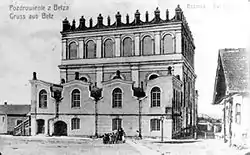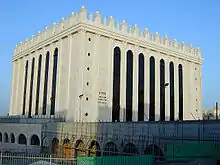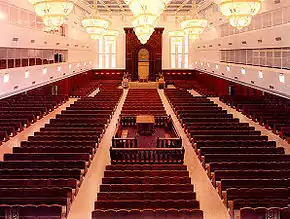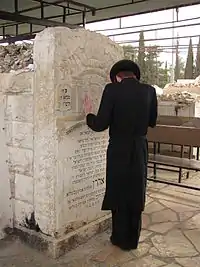Belz (Hasidic dynasty)
Belz (Yiddish: בעלזא) is a Hasidic dynasty founded in the town of Belz in Western Ukraine, near the Polish border, historically the Crown of the Kingdom of Poland. The group was founded in the early 19th century by Rabbi Shalom Rokeach, also known as the Sar Shalom, and led by his son, Rabbi Yehoshua Rokeach, and grandson, Rabbi Yissachar Dov, and great-grandson, Rabbi Aharon, before the Nazi invasion of Poland in 1939. While Rabbi Aharon managed to escape Europe, most of the Belz Hasidim were killed. Rabbi Aharon re-established the Hasidut in Tel Aviv, Israel. Today, Belz is one of the largest Hasidic groups in Israel, and has sizable communities in England, Belgium, New York, New Jersey, Canada, and Australia.



History
The founder of the dynasty was Rabbi Shalom Rokeach, also known as the Sar Shalom, who was inducted as rabbi of Belz in 1817. He personally helped build the city's large and imposing synagogue. Dedicated in 1843, the building resembled an ancient fortress, with 3-foot-thick (0.91 m) walls, a castellated roof and battlements adorned with gilded gold balls. It could seat 5,000 worshippers, and had superb acoustics. It stood until the Nazis invaded Belz in late 1939. Though the Germans attempted to destroy the synagogue, first by fire, and then by dynamite, they were unsuccessful. Finally, they conscripted Jewish men in forced labour to take the building apart, brick by brick.
When Rabbi Shalom died in 1855, his youngest son, Rabbi Yehoshua Rokeach (served 1855–1894), became the next Rebbe. Belzer Hasidism grew in size during Rebbe Yehoshua's tenure and the tenure of his son and successor, Rabbi Yissachar Dov Rokeach (served 1894–1926).
Unlike other groups which formed yeshivas in pre-war Poland, Belz maintained a unique yoshvim program, developed by Rabbi Yissachar Dov, which produced many outstanding Torah scholars. The yoshvim were married and unmarried men who remained in the synagogue all day to study the Talmud, pray, and derive inspiration from their Rebbe. They were supported by local businessmen, and their food and other necessities were brought to them so they wouldn't have to leave the synagogue for even a short time. Some yoshvim even slept in the synagogue on benches. They typically remained in this program until the Rebbe would tell them to return home to their wives and families.
With the death of Rebbe Yissachar Dov in 1926, the mantle of leadership fell on his eldest son, Rabbi Aharon Rokeach, who was 49 years old at the time. A deeply spiritual, almost mystical man, who studied much and slept and ate little, Rebbe Aharon was known for his saintliness and his miracle-working capabilities. Many of his followers reported experiencing miraculous recoveries or successes after receiving his blessing, and flocked to his court by the thousands.[1]
Some of the most learned scholars of the generation were Hasidim of Belz, such as Rabbi Moshe Greenwald (Arugath HaBosem) and his descendants, Rabbi Sholom Mordechai Schwadron (Maharsham) and Rabbi Chanoch Dov Padwa (Cheishev Ho'ephod), who was very close to Rebbe Aharon of Belz.
Escape from Belz
With the outbreak of World War II, and the Nazi invasion of Poland (1939), the town of Belz was thrown into turmoil. From 1939 to 1944, it was occupied by Nazi Germany, as a part of the General Government. Belz is situated on the left, north waterside of the Solokiya river (affluent of the Bug river), which was the German-Soviet border in 1939–1941.
Rabbi Aharon Rokeach, known as the "Wonder Rebbe", was at the top of the Gestapo's "wanted list" of rabbis targeted for extradition and extermination during the Nazi occupation of Poland. With cash inflow from Belzer Hasidim in Switzerland, England, and the United States, the Rebbe and his brother, Rabbi Mordechai of Bilgoray, 22 years younger than his brother, managed to stay one step ahead of the Nazis in one escape attempt after another. Notwithstanding the watchful presence of Gestapo patrols at every turn, the pair was spirited out of Premishlan into the Kraków Ghetto, and then to the Bochnia ghetto. In their most hair-raising escape attempt, the brothers were driven out of occupied Poland, and into Hungary, by Major General István Újszászy, head of the Vkf2 Hungarian counter-intelligence, who was friendly to Jews and acting on orders of Hungarian Regent Admiral Miklós Horthy. The Rebbe, his brother, and his attendant, shorn of their distinctive beards and payot (sidelocks), were disguised as Russian generals who had been captured at the front and were being taken to Budapest for questioning.[1]
Rebbe Aharon and Rabbi Mordechai spent eight months in Budapest, before receiving highly rationed Jewish Agency certificates to enter Palestine. In January 1944, they boarded the Orient Express to Istanbul. Less than two months later, the Nazis invaded Hungary, and began deporting its 450,000 Jews.
Rebuilding the dynasty in Israel
.jpg.webp)
Although he had lost his entire family — including his wife, children, grandchildren, and in-laws and their families — to the Nazis, Rebbe Aharon re-established his Hasidic court in Tel Aviv, where there was a small Hasidic community. Both he and Rabbi Mordechai (who had lost his wife and daughter) remarried, but only Rabbi Mordechai had a child, Yissachar Dov Rokeach, in 1948. Rabbi Mordechai suddenly died a year later, at the age of 47. Rebbe Aharon took his brother's son under his wing to groom him as the future successor to the Belz dynasty.
Like nearly all of the other groups originating in Poland, Belzer Hasdism was nearly wiped out by the Holocaust. Some Hasidic followers from other communities joined Belz after the war, following the deaths of their rebbes. Belz, like Ger and Satmar, was comparatively fortunate in that its leadership remained intact and survived the war, as opposed to many other Hasidic groups which suffered losses both in terms of rank-and-file supporters, as well as the murder of their leaders.
Rebbe Aharon became an acknowledged leader of Haredi Judaism in Israel. He laid the groundwork for the spread of Belzer Hasidism through the establishment of schools and yeshivas in Tel Aviv, Bnei Brak, and Jerusalem. In 1950, the Rebbe moved his court to the Jerusalem neighborhood of Katamon, and established a yeshiva there. His sights set on expanding Belz, he drew up plans for a large yeshiva and study hall in downtown Jerusalem, on a hill behind the original Shaarei Tzedek Hospital. The cornerstone was laid in 1954, and the building was completed in the summer of 1957. One month later, however, the Rebbe died.
Tens of thousands of admirers followed his casket to his burial site in Jerusalem. His nephew, Yissachar Dov, was nine years old at the time. For the next nine years, the movement did not have an active Rebbe. Yissachar Dov married at the age of 18 to the daughter of the Vizhnitzer Rebbe, Rabbi Moshe Yehoshua Hager, and moved to Bnei Brak to be close to his new father-in-law. A year later, he returned to Jerusalem to assume leadership of the Belz movement. His son and heir, Aharon Mordechai Rokeach, was born in 1975.
Belz today

Since 1966, Rabbi Yissachar Dov Rokeach has presided over both the expansion of Belz educational institutions and the growth of Hasidic populations in Israel, the United States, and Europe. Like other Hasidic groups, the Belz community has established a variety of self-help organizations, including one of the largest patient-advocacy organizations of its kind, a free medical counseling center, and an affordable medical treatment clinic in the New York area.[2]
Under the Rebbe's leadership, the Belz Hasidut has grown from a few hundred families at the time of his accession to leadership in 1966, to over 7,000 families, as of 2011.[3] The rebbe also led his Hasidim to the great split between the Belz and Satmar sects: The Rebbe held a fiery speech against the shittah (theory) of the then-Satmar Rebbe, Joel Teitelbaum, in which he denounced the Satmar Rebbe's actions and beliefs regarding Zionist philosophy and the Jewish state, initiating a permanent split between the two groups.
United Kingdom
In London, the Belz community is now centred in Stamford Hill.[4] In the 1930s, an early Belz synagogue was on Commercial Road, Limehouse, in the East End.[5]
In 2015, its community leaders, in accordance with guidance from the Belzer Rebbe in Israel, Rabbi Yissachar Dov Rokeach, stated that women driving cars was against traditional rules of modesty. In conjunction with Belz educational leaders, a policy was introduced of not allowing pupils to attend the school if their mothers drive.[4][6] The Department for Education launched an investigation, and the Secretary of State for Education, Nicky Morgan, stated that any such restriction is "completely unacceptable in modern Britain". In response, a Belz community spokesman said it never intended to "stigmatise or discriminate against children or their parents", and that the issue had been misrepresented.[7][8]
United States and Canada
Belz in the USA was founded in the 1800s, in the time of the Third Belzer Rebbe, Yissachar Dov Rokeach. The first Belz synagogue was rented in East Side Manhattan. Today, the largest number of Belzer Hasidim outside of Israel are living in the USA, mostly in the Borough Park neighborhood of Brooklyn, New York, which has ten Belzer synagogues and ten rabbis. Belz is one of the biggest Hasidic communities in Borough Park, exceeding Vizhnitz, Munkatch, and Ger. Belz in the New York metropolitan area has also communities and synagogues in Williamsburg, and in Staten Island. Some more Belz communities in New York State are located in Monsey, New York, and Spring Valley, New York. A new Belz development site was built 2015 in Lakewood, New Jersey. Belz is operating 5 local summer camps – 3 in the Catskill Mountains, one in Saratoga Springs, New York, and one in Val-Morin, Quebec. Belz in the USA and Canada counts over 3000 families; Belz operates 4 local Yeshiva Ketanas – two in the New York metropolitan area, one in Monsey, New York, and one in Montreal, Quebec. In December 2015, Belz bought a half-acre property in West Brighton, Staten Island, for $1.8 million, to develop a new Yeshiva Ketana complex.[9] Belz hosted New York City mayoral candidate Bill de Blasio in 2013 at an annual Dinner. The dinner took place in Brooklyn.[10]
The Belz World Center

In the 1980s, Rabbi Yissachar Dov spearheaded plans for a huge synagogue to be erected in the Kiryat Belz neighborhood of Jerusalem. The building, which would have four entrances accessible to each of the four streets of the hilly neighborhood, would be an enlarged replica of the structure that the first Rebbe of Belz, the Sar Shalom, had built in the town of Belz. It would include a grandiose main synagogue, smaller study halls, wedding and Bar Mitzvah halls, libraries, and other communal facilities.
Funds for this ambitious project were raised among Belzer Hasidim, and were supplemented by various fund-raising projects throughout the 1980s and 1990s.
Like the original synagogue of Belz which took 15 years to complete, the new Beis HaMedrash HaGadol (Great Synagogue) that now dominates the northern Jerusalem skyline also took 15 years to construct, and was dedicated in 2000. Its main sanctuary seats 6,000 worshipers (though crowds on the High Holy Days exceed 8,000), making it one of the largest Jewish house of worship in the world. A huge ark has the capacity to hold 70 Torah scrolls. Nine chandeliers in the main synagogue each contain over 200,000 pieces of Czech crystal.
In stark contrast to the majestic synagogue, the simple wooden chair and shtender used by Rabbi Aharon Rokeach when he came to Israel in 1944 stand in a glass case next to the ark.[11]
Lineage of Belzer dynastic leadership

Rabbi Sholom Rokeach, the founder of the Belz dynasty, was a disciple of the Seer of Lublin. The Seer was a disciple of Rabbi Elimelech Lipman of Lizhensk, author of Noam Elimelech. Rabbi Elimelech was a disciple of the Rebbe Dovber, the Maggid (Preacher) of Mezeritch, the primary disciple of the Baal Shem Tov, the founder of Hasidism.
- First Belzer Rebbe: Shalom Rokeach of Belz (1779–1855), also known as the Sar Shalom. Rebbe from 1817 to 1855. Disciple of the Seer of Lublin.
- Second Belzer Rebbe: Yehoshua Rokeach of Belz (1825–1894) – youngest son of the Sar Shalom. Rebbe from 1855 to 1894.
- Third Belzer Rebbe: Yissachar Dov Rokeach (1854–1926) – son of Yehoshua Rokeach. Rebbe from 1894 to 1926.
- Fourth Belzer Rebbe: Aharon Rokeach (1877–1957), also known as Reb Arele and as the Kedushat Aharon – eldest son of Yissachar Dov Rokeach. Rebbe from 1926 to 1957.
- Fifth Belzer Rebbe: Yissachar Dov Rokeach (b. 1948) – only son of Rabbi Mordechai of Bilgoray; nephew to Rebbe Aharon; son-in-law of Rebbe Moshe Hager of Vizhnitz. Rebbe from 1966–present.
- Fourth Belzer Rebbe: Aharon Rokeach (1877–1957), also known as Reb Arele and as the Kedushat Aharon – eldest son of Yissachar Dov Rokeach. Rebbe from 1926 to 1957.
- Third Belzer Rebbe: Yissachar Dov Rokeach (1854–1926) – son of Yehoshua Rokeach. Rebbe from 1894 to 1926.
- Second Belzer Rebbe: Yehoshua Rokeach of Belz (1825–1894) – youngest son of the Sar Shalom. Rebbe from 1855 to 1894.
Belz yeshivas
Belz maintains 10 yeshivas in Israel: 5 yeshiva gedolas (including two in Jerusalem, and one each in Bnei Brak, Ashdod, and Haifa); 5 yeshiva ketanas (in Telzstone, Bnei Brak, Ashdod, Beit Hilkia, and Komemiyut); and 6 other yeshiva ketanas around the world — in Antwerp, London, Montreal, Monsey, and two in Borough Park, Brooklyn.
Notable Belz Hasidim
- Yaakov Yechezkiya Greenwald (1882–1941), rabbi
- Shulem Lemmer (born 1989), singer
- Yaakov Yitzhak Neumann (1920–2007), rabbi
- Aharon Mordechai Rokeach (born 1975), rabbi
- Mordechai Rokeach (1902–1949), rabbi
See also
References
- Israel, Yosef (2005). Rescuing the Rebbe of Belz. Mesorah Publications, Ltd. ISBN 1-57819-059-2.
- "Tribute to Rabbi Yisocher Dov Rokeach, the Belzer Rebbe, Upon His Visit to New York – Hon. Jerrold Nadler" (PDF). Congressional Record, 104th Congress (1995–1996). 20 June 1995. Retrieved 11 September 2010.
- Landesman, Yerucham. "Born to Lead: How did the Belzer Rebbe breathe new life into a shattered Chassidus?" Mishpacha, 10 October 2011, pp. 30–51.
- Simon Rocker (28 May 2015). "Stamford Hill sect bans women drivers". Jewish Chronicle. Retrieved 29 May 2015.
- "Memories of the Belzer synagogue". Jewish East End. Retrieved 31 May 2015.
- Aisha Gani (28 May 2015). "Hasidic sect tells London mothers to stop driving". The Guardian. Retrieved 29 May 2015.
- "Orthodox Jewish women driving ban unacceptable, says Nicky Morgan". BBC. 29 May 2015. Retrieved 31 May 2015.
- Aisha Gani and Jessica Elgot (29 May 2015). "Orthodox Jewish sect's female driver ban condemned by Nicky Morgan". The Guardian. Retrieved 31 May 2015.
- "Half-acre West Brighton property sells for $1.8 million". SILive.com. Retrieved 2017-02-08.
- Ralph. "Bill de Blasio Introduced at Belz Dinner as the "Next Mayor of NYC"". matzav.com. Retrieved 2017-02-08.
- Spiegel, Yisroel (28 June 2000). "The Belz Beis Medrash in Yerushalayim: Full Circle". De'iah Ve'Dibur. Archived from the original on 4 August 2009. Retrieved 11 September 2010.
External links
| Wikimedia Commons has media related to Belz (Hasidic dynasty). |
Sources
- Rossoff, Dovid (1998). Where Heaven Touches Earth: Jewish Life in Jerusalem from Medieval Times to the Present. Jerusalem: Guardian Press. ISBN 0-87306-879-3.
